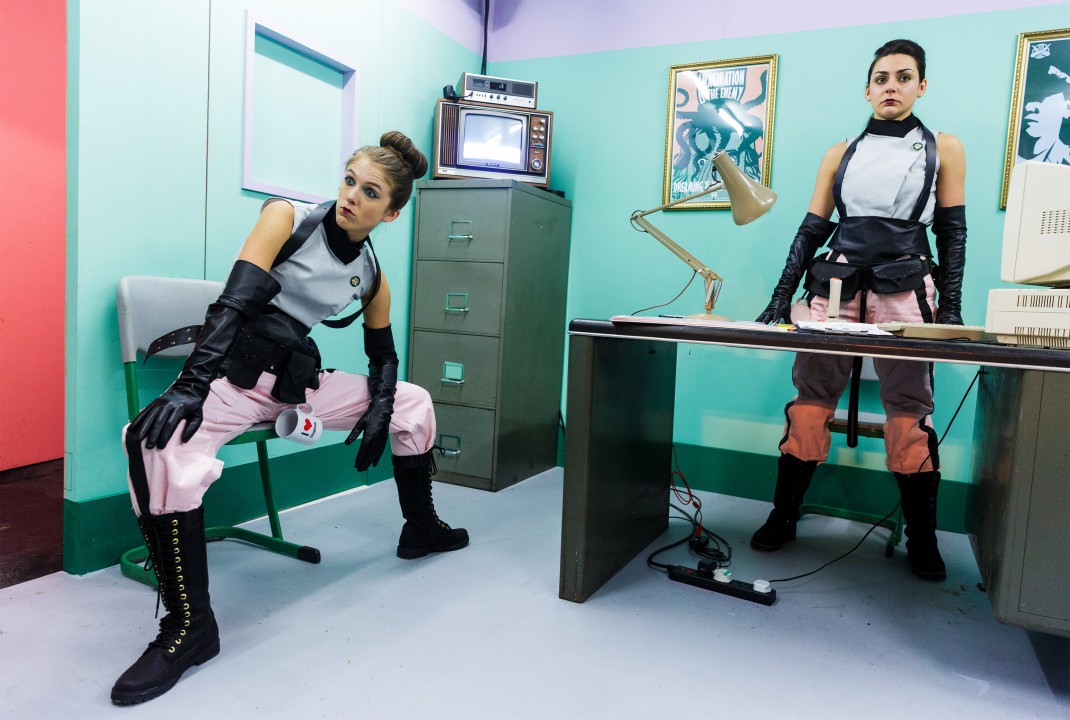RÓISÍN TAPPONI and XARA ZABIHI DUTTON review Les Infants Terribles’ Inside Pussy Riot.
Inside Pussy Riot is an immersive theatre piece about the arrest, trial and imprisonment of the Russian punk band members, Maria Alyokhina, Nadezhda Tolokonnikova and Yekaterina Samutsevich. Pussy Riot were arrested for so-called hooliganism, following their performance of the incendiary ‘Punk Prayer’ at Christ the Saviour Cathedral in 2013. Theatre company Les Enfants Terribles, who produced the piece in collaboration with Pussy Riot, play out the band’s experience in a humorous yet provocative way, while retaining elements of the band’s punk spirit. The silence forced upon the audience during Inside Pussy Riot imitates the forced submission of Pussy Riot’s unfair trial. The Saatchi Gallery becomes a vacuum – voices are put on hold as the audience are constantly reminded to ‘stay silent’ by the actors. However, once audience members leave the performance space, Inside Pussy Riot prompts anything but silence.

The set is permeated with female stereotypes, shaded with pinks, oranges, bubble gums. But this impression of decorous femininity is dispelled as the piece progresses. In the prison workroom scene, a (female) actor patrols, dressed as a male guard, whispering lurid phrases (‘You alright princess?’) into the ears of audience members. This introduces the idea that there isn’t just a state power structure within the prison system, but a patriarchal power structure. The piece conveys the sense that within Russian society, state power, patriarchal power, and the power of the Orthodox Church are intrinsically linked. Instead of saints being depicted on the stained glass in the Church scene, the faces of Trump and Farage are featured, suggesting that populist figures have assumed God-like roles in the modern age. The female voice is disturbed by the volume of the male voice, shown overtly by the priest and judge characters, who assert order through intimidation and verbal abuse. For instance, in the play Putin is a looming figure — his silhouette pervades the set. There is a particularly striking moment when the judge receives a phone call from him; they have a strangely emotional conversation ending in ‘I love you’, satirising the inappropriate nature of the intervention of the state in the judicial system.
The piece navigates a fine line between drawing wider publicity to an important issue, and exploiting the experiences of a few fringe activists for the commercial benefit of institutions that perpetuate the very systems of oppression protested against. Inside Pussy Riot is exhibited by the Saatchi Gallery, which houses Charles Saatchi’s voluminous collection of art. Charles Saatchi is also the director and founder of Saatchi & Saatchi, an advertising agency. Ironically, this tension is enacted within the show. The subversive Pussy Riot and the institutional Saatchi Gallery are incongruous companions.

The issue of freedom of speech and liberty is also at odds with the apparent desire to provide palatable entertainment for an expectant audience. In an incredibly elaborate court scene, the audience is positioned in a cage with a puppet-strung judge looming overhead in a clownish costume. This hyperbolic representation makes it easier to criticise the state, because the state’s behaviour is presented in a manner that simplifies its actions to absurdity, losing subtlety and failing to fully engage with the complex political situation. Such a representation is clearly satirical, but the hackneyed metaphor of the justice system as a puppet show fails to do justice to the raw violence of the situation. The commentary of this scene was somewhat similar to that of Banksy’s Dismaland, which also explored political and social issues using clichéd images to pander to a wider audience. Both pieces’ capacity to be subversive was undermined by what appeared to be a commercial agenda.
The overall experience was, more than anything, entertaining, with Inside Pussy Riot using self-referential humour, breaking the fourth wall and exploring the boundaries between performers and audience. While the use of satire made the message easier to digest emotionally, the piece had a greater unfulfilled potential to agitate the audience into a proactive response to the oppression suffered by Maria, Nadezhda and Yekaterina . At the end of the experience, the audience is allowed a moment for silent reflection, during which a recorded message from Nadezhda plays. The poignant aphorism included in the final scene, ‘Take the revolution seriously, but do not take yourself seriously’, captures the tone of the performance, and provides a neat, take-home message for an audience expectant and eager to perform the style of accessible social activism inspired by the performance.
Inside Pussy Riot is running at the Saatchi Gallery until December 24th. Find tickets and more information here.
Featured image courtesy of Kenny Mathieson.





